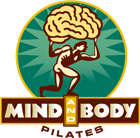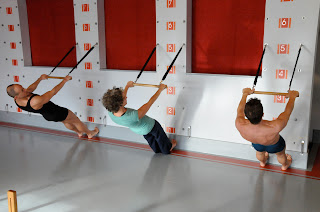Here are some excerpts from an Article written by Dallas Hartwig – a Physical Therapist and Crossfit instructor (@ Whole9life.com). He makes some very good points about how much technique should be allowed to degrade in an intense workout (whether it be Crossfit or Pilates or some other hardcore class).
Food for thought and I must say, I think he is right. I have often told myself to really focus on technique when I get into these intense workouts. It weird that some silly sense of competition would trick me into doing myself harm but it happens. And more than once I have caught myself degrading to 60% technique in order to get finished faster. Mea culpa.
He writes:
Performing exercises properly and paying attention to the subtleties of the movement will determine whether my client sees an increase in physical capacity, or is plagued by injury (now, or in the future) as the result of the reinforcement of incorrect and unsafe motor patterns. . . . But given my professional experience, I’d rather err on the side of exceptional technique than prioritize maximal intensity at the expense ofquality of movement.
According to a Crossfit certification seminar on intensity, “Unsafe is unacceptable, but so is perfect form.” The instructor explained, “If you’re doing high-rep deadlifts and your back starts to round, that’s unsafe and unacceptable. But if you’re doing that same set of deadlifts with perfect form on every rep, that’s also unacceptable. You’ve either gone too light (in weight), or you’re not working hard enough.” This ideal is referred to as ‘CrossFit slop’.” The ‘slop’ ideal is often cited within the CrossFit community as 20% form degradation (compared to 100% perfect form). According to CrossFit theory, that’s the optimal balance of effort and safety. “That’s where intensity lives. Technique has to be good enough to increase intensity, but you should never strive for perfect form.”
Hartwig writes:
And here’s where I take issue with this concept of “intensity is king.” In my experience, the 20% ‘slop’ advocated by CrossFit often devolves into a 50% slop in practical application, especially with longer length, high-rep met-cons. (Lighter movements, like those usually prescribed in a chipper workout, can almost always be completed any which way, even with form that makes your eyes bleed.) I’ve seen patellar tendonitis from high-volume air squats, strained shoulders from shoddy thruster technique, and tweaked lumbar spines from high rep deadlifts pulled with careless form, all driven by the pursuit of “intensity”.
At the Whole9, 20% slop isn’t good enough. You don’t get to move up in weight – or go faster – unless your form is really, truly solid. (I use my “A-minus” grade as a subjective criteria – not perfect, but pretty darn good). In addition, your “max effort” pulls will not count here if they’re hideous. And don’t give me the “in the real world, it doesn’t have to look pretty” argument, either. Sure, I’ve seen 500 pound deadlifts PRs that look like question marks… but those strong dudes didn’t get that way by training with that technique. That degradation in form is acceptable when it matters, like lifting a fallen tree off a family member, carrying an injured comrade out of harm’s way, or even non-emergency, one-time situations like competing in a lifting meet. But folks, your everyday CrossFit workout is not that time. Imperfect form in the desperation of an emergency or during a real-world, functional “test” does not justify that level of form degradation during your training.When we train, our goal is to build the strength, practice good technique, and reinforce only proper movement patterns. And despite what your ego may be telling you (go heavier, tough it out, rip it up), I assure you that our approach will serve you well when it’s time to pull a max effort clean, some fast met-con deadlifts or give Grace a go. Your technique will be solid, your times will improve and you’ll walk away from the gym stronger and fitter, instead of broken and hurting. Still choose to operate with that 20% margin of “CrossFit slop”? You can certainly work harder, produce more power, and maybe even be fitter than me with that approach. But you’re sure as hell going to be injured more often too. I have yet to hear a patient tell me, “Well, my shoulder has been hurting pretty bad for the last 3 weeks, but I sure am glad I cut 7 seconds off my Fran time.” How hard can you train when you’re All Banged Up? I’ll answer that for you, from personal experience – not hard enough to maintain the well-rounded fitness we seek.


